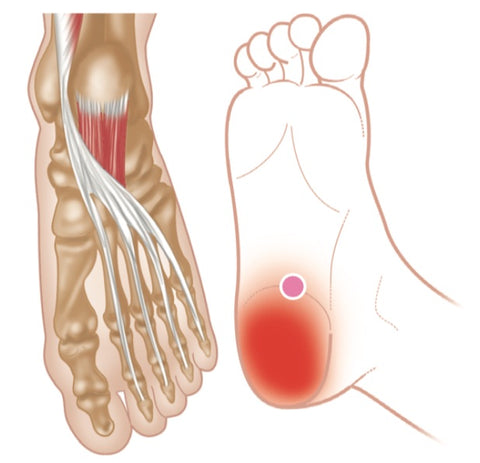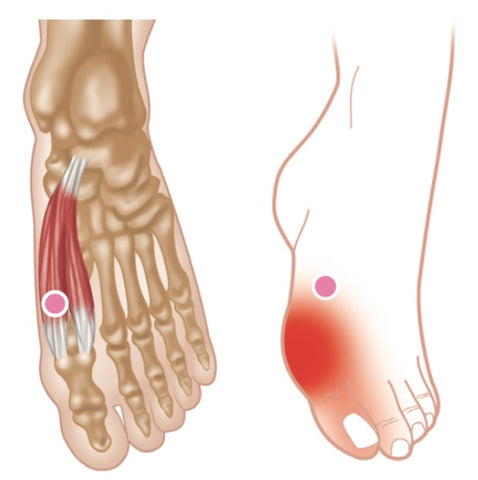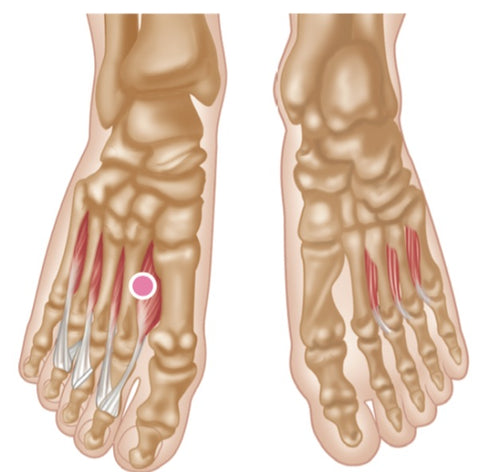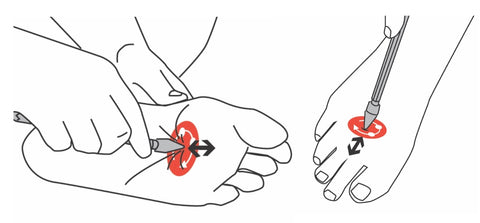Using Cupping to Treat the Deep Muscles of the Foot
Posted by Stuart Hinds on
Stuart Hinds demonstrates the use of cupping to treat Plantar Fasciitis
Cupping is a technique adapted from Traditional Chinese Medicine. Cupping is often used in conjunction with trigger point therapy, acupuncture or dry needling. It pulls blood to a region to stimulate healing and can be used effectively for stretching tight fascia and muscles.
Deep Muscles of the Foot
These comprise of Quadratus Plantae, Adductor Hallucis, Flexor Hallucis Brevis, Dorsal Interossei and Plantar Interossei.

Quadratus Plantae

Adductor Hallucis

Flexor Hallucis Brevis

Dorsal Interossei (left), Plantar Interossei (right)
Origin
Quadratus plantae: medial head—medial surface of calcaneus; lateral head—lateral border of inferior surface of calcaneus.
Adductor hallucis: oblique head—bases of 2nd, 3rd, and 4th metatarsals. Sheath of peroneus longus tendon; transverse head— plantar metatarsophalangeal ligaments of 3rd, 4th, and 5th toes. Transverse metatarsal ligaments. Antagonist: abductor hallucis.
Flexor hallucis brevis: medial part of plantar surface of cuboid bone. Adjacent part of lateral cuneiform bone. Tendon of tibialis posterior. Antagonist: extensor hallucis longus.
Dorsal interossei: adjacent sides of metatarsal bones. Antagonist: plantar interossei.
Plantar interossei: bases and medial sides of 3rd, 4th, and 5th metatarsals. Antagonist: dorsal interossei.
Insertion
Quadratus plantae: lateral border of tendon of flexor digitorum longus.
Adductor hallucis: lateral side of base of proximal phalanx of great toe.
Flexor hallucis brevis: medial part—medial side of base of proximal phalanx of great toe; lateral part—lateral side of base of proximal phalanx of great toe.
Dorsal interossei: bases of proximal phalanges: 1st—medial side of proximal phalanx of 2nd toe; 2nd to 4th—lateral sides of proximal phalanges of 2nd to 4th toes.
Plantar interossei: medial sides of bases of proximal phalanges of same toes.
Action
Quadratus plantae: flexes distal phalanges of 2nd to 5th toes. Modifies oblique line of pull of flexor digitorum longus tendons to bring it in line with long axis of foot.
Adductor hallucis: adducts and assists in flexing metatarsophalangeal joint of great toe.
Flexor hallucis brevis: flexes metatarsophalangeal joint of great toe.
Dorsal interossei: abduct (spread) toes. Flex metatarsophalangeal joints.
Plantar interossei: adduct (close together) toes. Flex metatarsophalangeal joints.
Nerve
Quadratus plantae, adductor hallucis, dorsal interossei, plantar interossei: lateral plantar nerve, S1, 2.
Flexor hallucis brevis: medial plantar nerve, L4, 5, S1.
Basic Functional Movement
Examples: holding a pencil between toes and ball of foot; helping to gather up material under foot by involving great toe; making a space between great toe and adjacent toe; facilitating walking.
Referred Pain Patterns
Quadratus plantae—heel pain; adductor hallucis—forefoot pain; flexor hallucis brevis—pain around 1st metatarsophalangeal joint; dorsal/plantar interossei—2nd digit pain (anteroposterior).
Indications
Foot/heel pain, pain in 1st metatarsophalangeal joint, bunions/hallux valgus, pain in 2nd toe, forefoot pain, stiffness in tissues (inability to use orthotic support), problems with walking, numbness in foot, hip/knee/ankle pain, heel spur, plantar fasciitis (quadratus plantae).
Causes
Arthritic toes, poor footwear (heels) or orthotics, sports (e.g. swimming, walking, jogging, running, sprinting), hypomobile ankles, toe clawing, trauma, chilling in wet socks/cold water.
Differential Diagnosis
Morton’s neuroma. Metatarsalgia. Plantar fasciitis. Heel spur. Stress fracture. Articular (joint) dysfunctions. Injured sesamoid bones. Lumbar radiculopathy (foot drop). Hallux valgus. Calcaneal compartment syndrome. Gout. Arthritis.


Try using a pencil with a rubber eraser to address these trigger points
General Advice
Stretching with cold (and/or hot). Examine footwear (is it too tight?). Treat any joint dysfunctions. Stretching exercises/home stretch over tennis/golf ball. Proper orthotics. Gait/posture analysis.
Self-pressure and/or pressure tools are recommended, as these muscles respond well to pressure. Try the pencil with a rubber tip techniques.
Trigger Point Therapist Power Pack - Three Courses In-One!
Soft Tissue Release Master Course
About the author
Stuart Hinds is one of Australia’s leading soft tissue therapists, with over 27 years of experience as a practitioner, working with elite sports athletes, supporting Olympic teams, educating and mentoring others as well as running a highly successful clinic in Geelong.
Stuart has a strong following of practitioners across Australia and globally who tap into his expertise as a soft-tissue specialist. He delivers a range of highly sought after seminars across Australia, supported by online videos, webinars and one-on-one mentoring to help support his colleagues to build successful businesses.
In 2016, Stuart was awarded a lifetime membership to Massage & Myotherapy Australia for his significant support and contribution to the industry.
This trigger point therapy blog is intended to be used for information purposes only and is not intended to be used for medical diagnosis or treatment or to substitute for a medical diagnosis and/or treatment rendered or prescribed by a physician or competent healthcare professional. This information is designed as educational material, but should not be taken as a recommendation for treatment of any particular person or patient. Always consult your physician if you think you need treatment or if you feel unwell.

Thanks for the practical advise and images, makes so much more sense.
Thank you for sharing this great information , really very informative and helpful , Thank you once again.